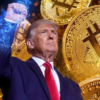
Bitcoin (BTC) price edges below $82,000 at the time of writing on Monday after falling 4.29% the previous week. BTC’s first quarter return for this year so far is -12.51%, the fourth lowest Q1 overall since 2013. Meanwhile, the US Economic Policy Uncertainty (EPU) Index reads 600, 80% higher than during the 2008 Global Financial Crisis, signaling extreme market unease and risk-off sentiment.
Risk-off sentiment and market uncertainty escalate amid Trump’s tariff deadline
Bitcoin price continues its correction on Monday, trading below $82,000 after falling 4.29% the previous week. The risk-off sentiment and market uncertainty escalate ahead of US President Donald Trump’s tariff deadline, the so-called ‘Liberation Day,’ on Wednesday. The reports from K33 Research and Kobeissi caution traders to anticipate increased volatility.
Moreover, the US Economic Policy Uncertainty (EPU) Index chart below, which measures uncertainty in US economic policy since 1985, currently stands over 600 — 80% higher than during the 2008 Global Financial Crisis, signaling extreme market unease. Historical spikes in the metric indicate high uncertainty often precedes significant market volatility, as seen during the 2008 crisis and the 2020 COVID-19 shutdown.
This high uncertainty and volatility market condition often precedes a risk-off sentiment in investors as they migrate toward safer assets like Gold, potentially dampening crypto demand.
On Monday, the Wall Street Journal (WSJ) reported that President Trump’s team is considering “broader and higher tariffs” ahead of Wednesday’s reciprocal tariffs deadline.
President Trump reportedly weighs “an across-the-board hike of up to 20%.” Again, Wednesday is not just the end of tariff uncertainty, according to a post from the Kobeissi Letter on X.
As uncertainty and volatility hit the global and crypto markets, volatility with potential sell-offs as risk-off sentiment dominates for crypto markets in the short term. However, over the medium to long term, Bitcoin and other cryptos could benefit from increased demand as hedges against inflation and economic uncertainty, especially if inflation rises and traditional markets falter. The historical correlation between EPU shocks and crypto volumes, alongside Bitcoin’s “haven asset” perception, supports this outlook, though short-term risks remain significant due to broader market dynamics.
To gain more insight into how crypto markets would react to these tariff policies, FXStreet interviewed some experts in the crypto markets in this report.
Bitcoin’s quarterly return is negative, while April historical monthly return suggests a mild recovery
According to Coinglass Bitcoin Quarterly returns (%) data, BTC Q1 shows negative returns this year, -12.51%, the worst Q1 since 2018 and the fourth lowest overall Q1 since 2013.
Looking at the monthly return chart below, March has registered a mild correction so far of 3.06%, while April historical data shows that the monthly average and median returns show positive gains of 12.98% and 5.04%, respectively, hinting at some optimism.
Bitcoin’s institutional demand data shows a diminishing demand for BTC. According to Coinglass, Bitcoin spot Exchange Traded Fund (ETF) data recorded a mild net inflow of $196.40 million last week after $744.30 million of inflows the previous week. These inflows are quite small compared to inflows seen during early November. For Bitcoin’s price to recover further, the demand from institutional investors should rise and intensify.










